Engagement Ring - In Progress
Setting
Stone
We guarantee that every single purchase directly impacts one person's life by giving them access to clean water.
Don’t: Amethyst, Opal, Pearl, Tanzanite, Morganite, Moss Agate
A gemstone engagement ring is a type of engagement ring that has a non-diamond center stone. Often designed using traditional engagement settings such as solitaires, halos, and three-stones, some couples choose less traditional settings to hold their less traditional center stone. Common gemstone choices include Sapphire, Emerald, and Ruby. Aquamarine engagement rings, Morganite engagement rings, Tanzanite engagement rings, Opal engagement rings, Moss Agate engagement rings, and Amethyst engagement rings are gaining popularity too. However, some of these stones will not stand up to daily wear.
There are many benefits to choosing a gemstone engagement ring, including personality, uniqueness, and cost. Learning the risks associated with choosing a gemstone over a diamond will help couples better care for their gemstone engagement ring, and feel confident in their choice.
Couples choose gemstone engagement rings for many reasons. Some like to express themselves in color. A bright red ruby engagement ring says passion. A dark blue sapphire engagement ring stands for loyalty. Couples love splashy oranges and pinks, and cool fresh greens. Gemstones are lively!
Another reason to consider a gemstone engagement ring is cost. Depending upon the stone, size, and color, gemstones are often a fraction of the cost of a similarly sized diamond. So, couples choosing a gemstone engagement ring can often afford a larger center stone in gemstone than in diamond.
Speaking of size, many gemstones regularly grow in large crystals. As a result, many gemstones are available in sizes and shapes that diamond is not. So, couples have the opportunity to choose large, fancy shapes for their special ring.
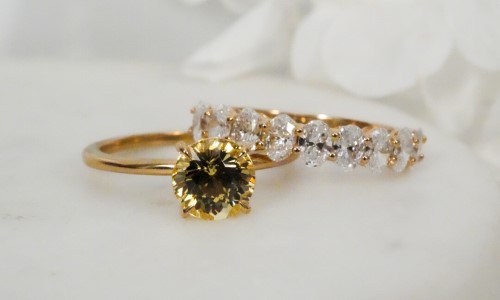
Yellow Sapphire Engagement Ring
While there are many benefits to gemstone engagement rings, there are risks to consider before purchase too. Because gemstones are not as hard as diamond, gemstone engagement rings may scratch or chip more easily. Couples can protect against this by choosing a hard gemstone, and by designing a protective setting.
Another issue to be aware of is that gemstones’ unique colors and shapes can be more difficult to replace in the event of loss or breakage. Because gemstones are often cut in less standard shapes than diamonds, couples may have a harder time finding the exact measurements of their original stone. Likewise, as gemstone color is so unique – consider all the various shades of “blue” at the paint store – finding the exact color you originally had can be tough. Couples can protect themselves by having a gemologist appraise and color grade their gemstone so they have an exact record.
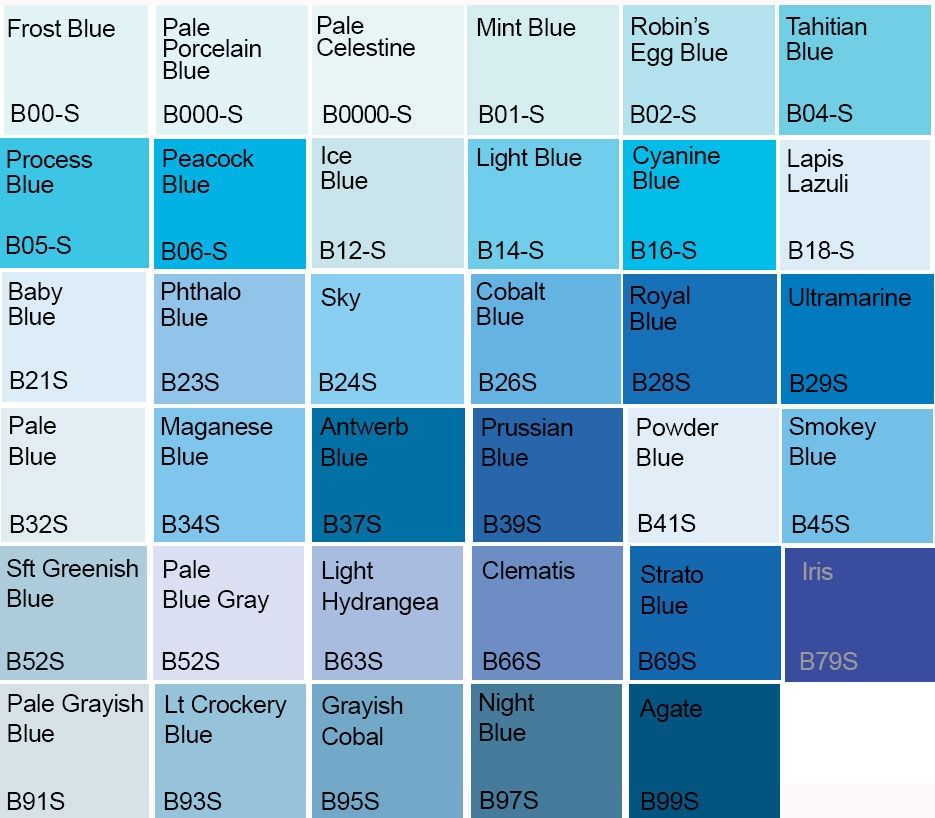
Shades of Blue, from Copic Markers
Some gemstones are – and some aren’t. One of the reasons you’ll hear a “diamond is forever” is because diamonds are a 10/10 on the Mohs Hardness Scale. This means that diamond is (literally) the hardest substance known to man. There is nothing that can scratch at diamond except for, you guessed it, another diamond. Non-diamond gemstones are not as hard. However, neither is the glass on your car’s windshield, the screen on your iPhone, or the table you’re sitting at right now. In other words, there’s still some pretty durable stuff out there. Let’s talk about how hard a gem needs to be in order to stand up to daily wear.
The Mohs Hardness Scale was developed to rank the hardness of gemstones and minerals. It goes from 1 (Talc) to 10 (Diamond). This is useful when trying to select a gemstone engagement ring center stone, because we know how hard daily life is. Huh? No seriously, hear me out.
You know, the stuff floating around in the air? That’s the stuff that will scratch your gemstone when you try to clean it. So, when choosing a gemstone engagement ring, your best bet is to choose a gemstone of 7.5/10 and above. The closer to 10/10 you get, the more durable your ring will be.
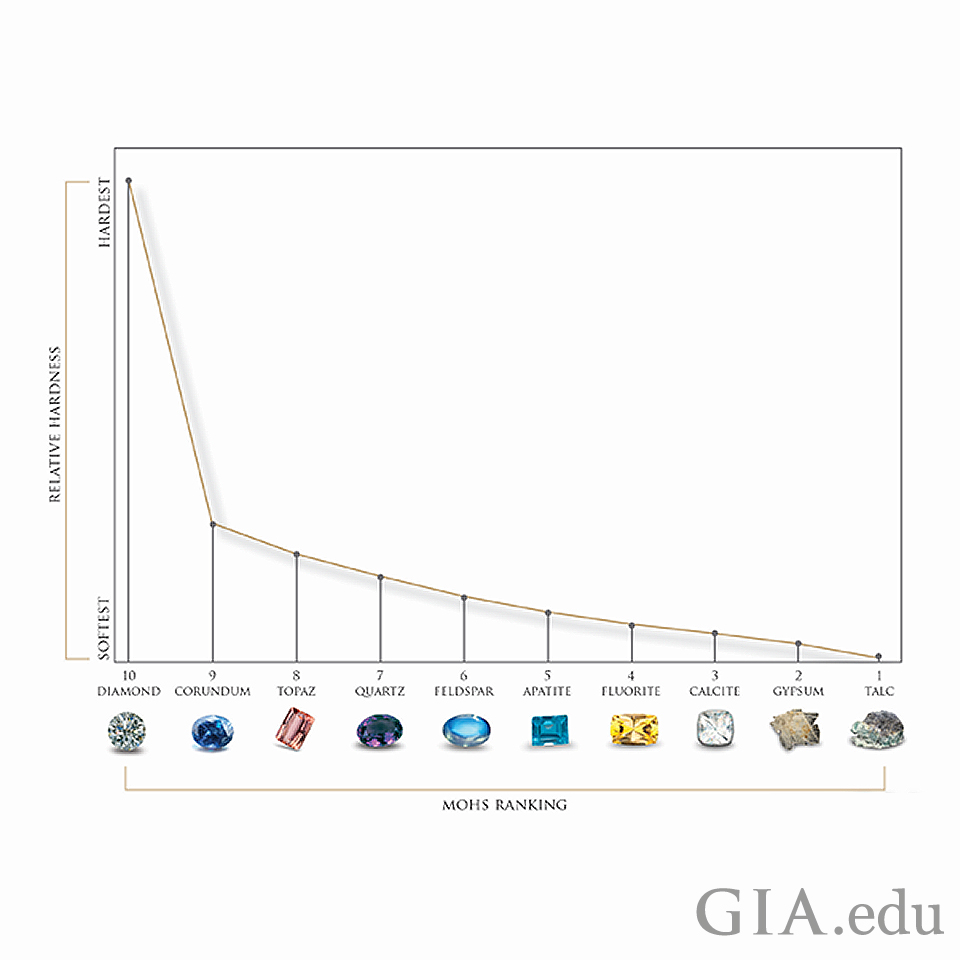
Mohs Hardness Scale. (Photo by: GIA)
Gemstones of a 7.5/10 on the Mohs Hardness Scale and above make the best engagement ring center stones. My own Spinel is an 8/10, and I still treat it very gingerly (and love it very much!) Let’s review some durable gemstone engagement ring options, in order of hardness:
Emerald is a beautiful, mystical green. It is durable, at a 7.5/10 on the Mohs Hardness Scale. Its name derives from Sanskrit, and it symbolizes growth and energy. Emerald comes in many shades, including pure green, yellow-green, and blueish-Green. It can be light or dark. As a Type III gemstone, Emerald often shows extensive eye-visible inclusions. In other words, don’t expect an Emerald to be flawless. Some people call an Emerald’s inclusions its “garden.” Couples choosing an Emerald engagement ring should take caution that inclusions which reach the surface of the gem may increase its risk for chipping. So, watch out for large inclusions which meet the edges of your stone. Also, make sure to choose an emerald engagement ring setting that protects any inclusions which may put the ring at risk.

Emerald Engagement Ring
Aquamarine is a shiny, light blue gem that symbolizes tranquility and healing. Unlike its sister, Emerald, Aquamarine is a Type I gem, meaning it should be pretty flawless. Like Emerald, it is a 7.5/10 on the Hardness Scale. Aquas can come in light, medium, and darker blue tones. It sometimes shows a hint of green, like the sea. Couples choosing an Aquamarine engagement ring should look for an eye-clean gem that shows its blue color. Lighter blues are less valuable than medium or medium-dark blues. Darker color blues will also help to hide when your Aquamarine engagement ring is not sparkling clean, whereas light blue shows dirt and oil much more easily.
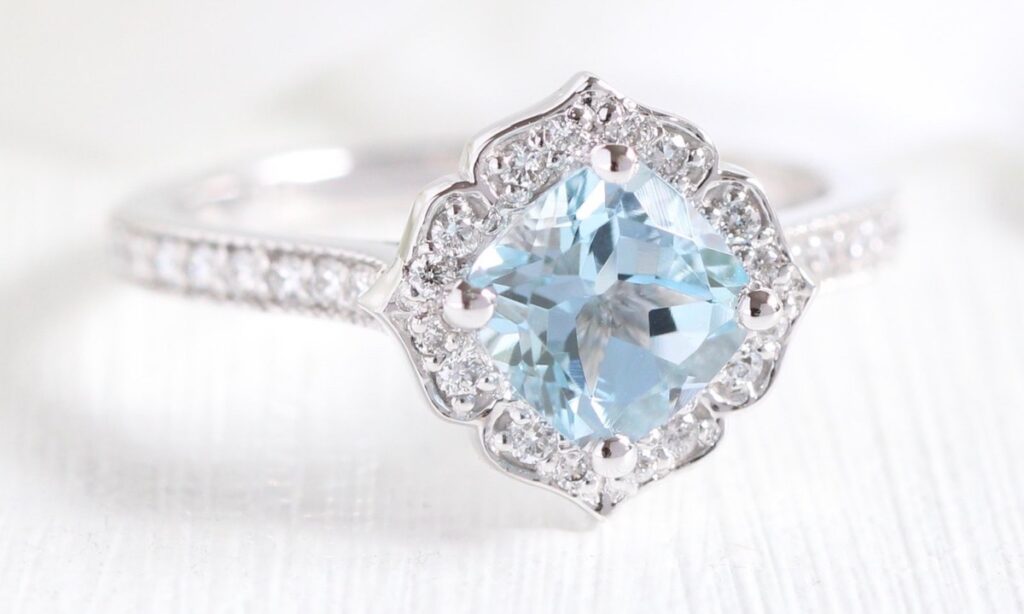
Aquamarine engagement ring. (Photo by: La More Design)
Topaz is an 8/10 on the Mohs Hardness Scale, making it a good engagement ring option. It symbolizes wealth and royalty. The most common color of Topaz today is blue, however it is also naturally found in colorless, pink, yellow, and peach hues. Blue Topaz comes in some massive crystals, making it a great choice for couples that want a huge look. When choosing a Topaz engagement ring, you should look for an eye clean stone with medium color.
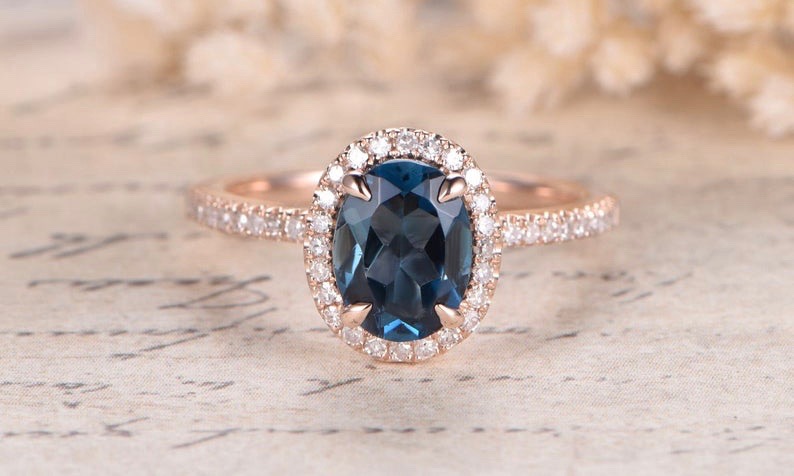
Topaz engagement ring.
My engagement ring is a Spinel! Although it is not commonly heard of, Spinel makes a good engagement ring choice due to its 8/10 hardness on the Mohs Scale and its vast array of colors. Spinel symbolizes power and protection. My Spinel is a blueish-Violet color, but I have also designed Spinel engagement rings in bright Pink and Black. The most sought after colors in this gemstone engagement ring are red, pink, and blue, as they can rival Ruby and Sapphire. Spinel is a Type II gemstone, which means they often have some inclusions, but can also be eye-clean. So, couples choosing a Spinel should look for an eye-clean stone in a color that speaks to them!
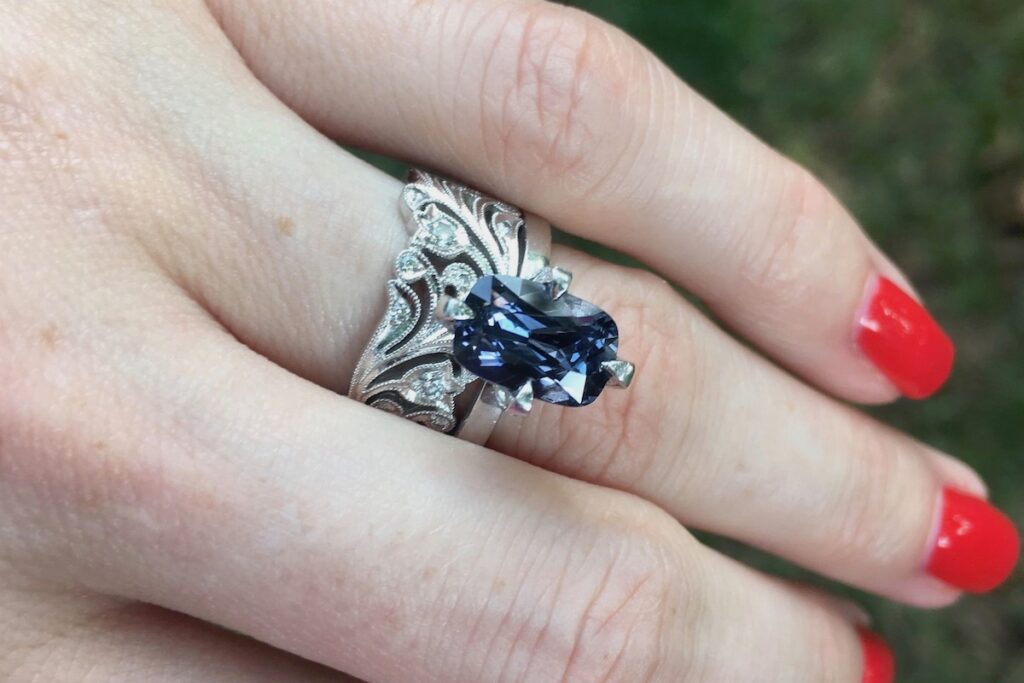
2.75ct Cushion Spinel Engagement ring.
Alexandrite is a great choice for an engagement ring due to its 8.5/10 Mohs hardness. It is the color-change version of the larger gem group Chrysoberyl, and symbolizes luck and balance. Alexandrite changes from green in daylight to red under a light bulb. Non-alexandrite Chrysoberyl comes in yellow, bronze, and green. Chrysoberyl symbolizes protection and healing. Chrysoberyl and Alexandrite are Type II gemstones, meaning they will have some inclusions, but eye-clean gems are available. So, couples choosing this engagement ring should look for eye clean gems.
When looking for an Alexandrite engagement ring, the most important thing to consider is the quality of its colors and color change. Couples looking for a Chrysoberyl engagement ring should seek out a pleasing, warm color.
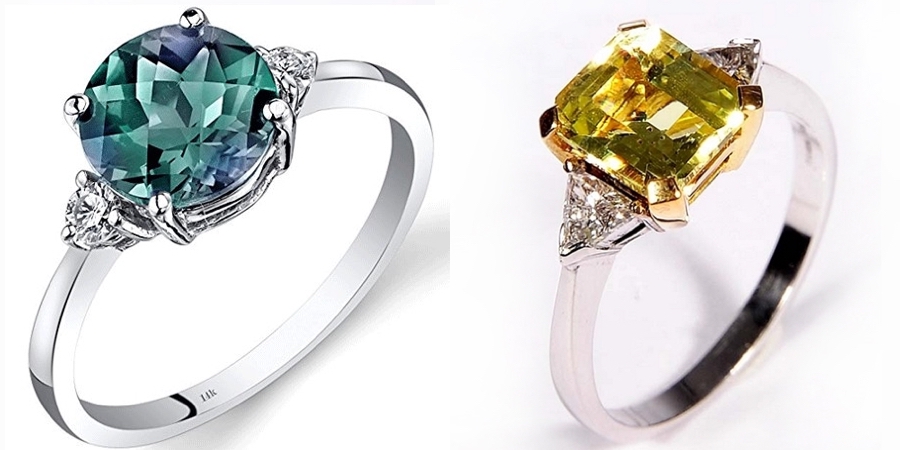
Left: Alexandrite engagement ring. | Right: Chrysoberyl engagement ring.
Sapphire and its sister, Ruby, are the hardest non-diamond gems available at a 9/10 on the Mohs Hardness Scale. Members of the gem family Corundum, red gems are Ruby, and all the other rainbow colors are Sapphire. A Sapphire engagement ring signifies loyalty. A Ruby engagement ring symbolizes love and passion. Sapphire and Ruby are Type II gems, meaning they will have some inclusions, but eye clean gems should be sought out. Rich medium tones (in other words, not too light and not too dark) are the most beautiful and valuable. Because of its superior hardness and crazy amount of colors, a Sapphire engagement ring is an excellent gemstone engagement ring choice. Likewise, due to its romantic color and great durability, couples looking for something different should definitely consider a Ruby engagement ring.
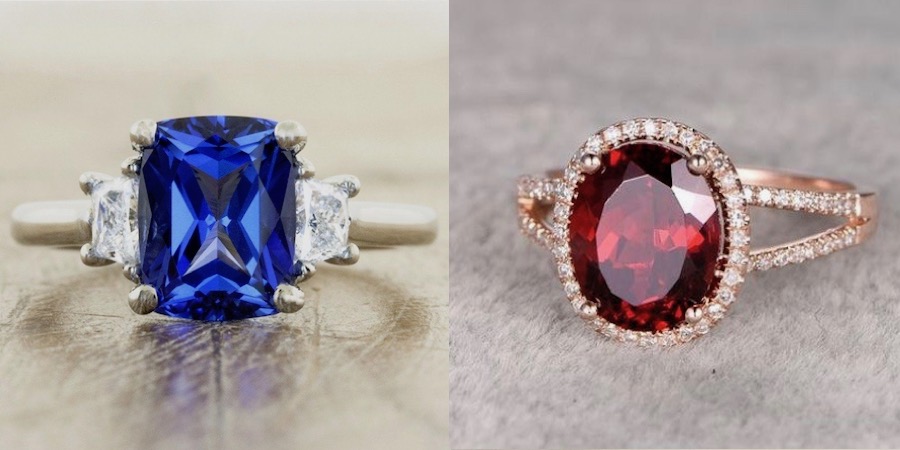
Left: Sapphire engagement ring. | Right: Ruby engagement ring.
Opals are beautiful shimmery gems that are very, very soft. A 5.5-6.5 on the Mohs Hardness Scale, in fact. So, even with extreme caution, there is a real chance the gem will break during normal wear. As a result, Opal engagement rings are not ideal. Instead, couples looking for an Opal engagement ring should check out Star Sapphire – much harder and just as unique!
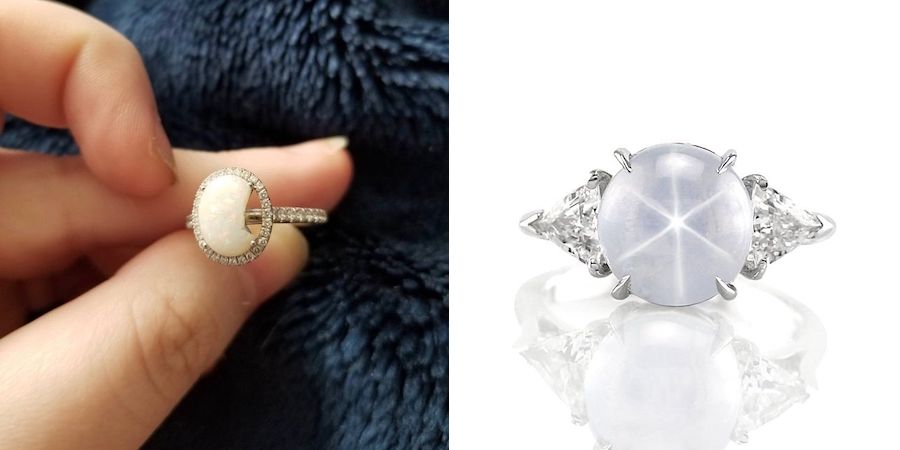
Left: Chipped Opal center stone. | White star sapphire engagement ring.
Morganite is a peachy-pink gem that is typically eye clean. It symbolizes love and innocence. This may sound like an ideal engagement ring choice, but real life gets in the way. Because of its light color and lack of significant sparkle, Morganite shows dirt and oil almost immediately. Even people who take great care of their rings will experience this, because, well, life. You have oil on your skin, put on makeup, use hairspray, wash your hands. So, instead of choosing a Morganite engagement ring, couples should check out Pink Topaz, Pink Spinel, or Pink Sapphire – much harder, and do not show dirt and oil as easily!
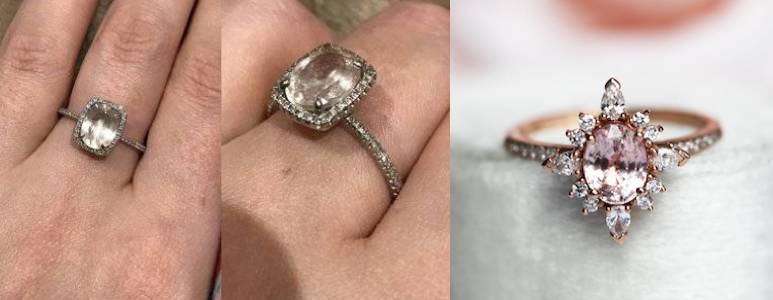
Left: Dull, dirty Morganite engagement ring. | Right: Pink sapphire engagement ring.
Pearl engagement rings are romantic. Unfortunately, they are also too soft, at a 2.5-4.5 on the Mohs Hardness Scale. Normal damage we see to Pearl engagement rings include loss of the pearl, dull spots where the nacre has worn off, and chipping. This is tragic! Instead, couples looking for a Pearl engagement ring should consider a white cabochon Sapphire instead. A sapphire engagement ring is much harder, and will last the test of time.
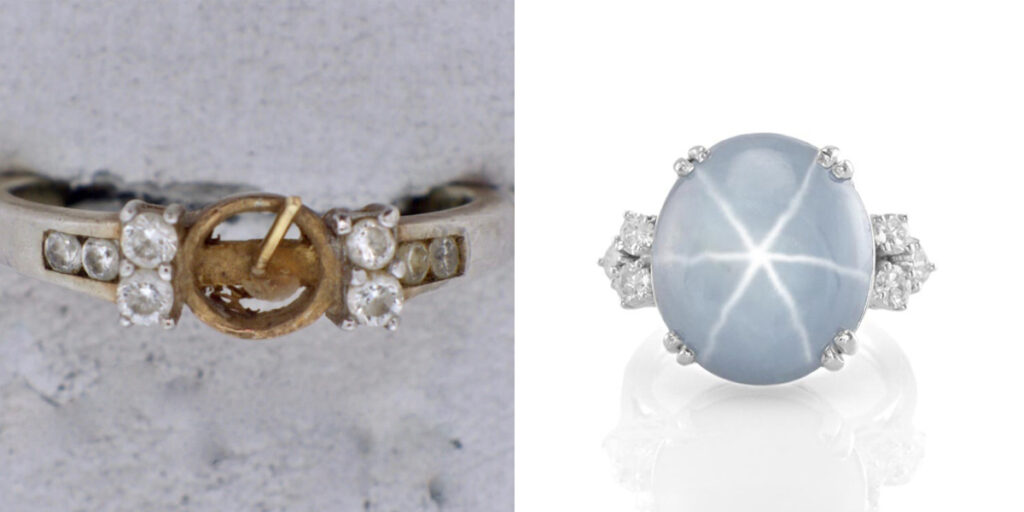
Left: Missing pearl in ring setting. (Photo by: MyJewelryRepair) | Right: Cabochon Sapphire engagement ring.
Amethyst is a rich, Welch’s grape purple that people adore for a unique engagement ring. Sadly, at a 7/10 on the Mohs Hardness Scale, Amethyst is the same hardness as dust. As a result, Amethyst will wear poorly over time, experiencing mini scratches until it is dull. That’s not what you want for an engagement ring! Instead, couples searching for an Amethyst engagement ring should check out Purple Sapphire which is much harder and will always be beautiful.
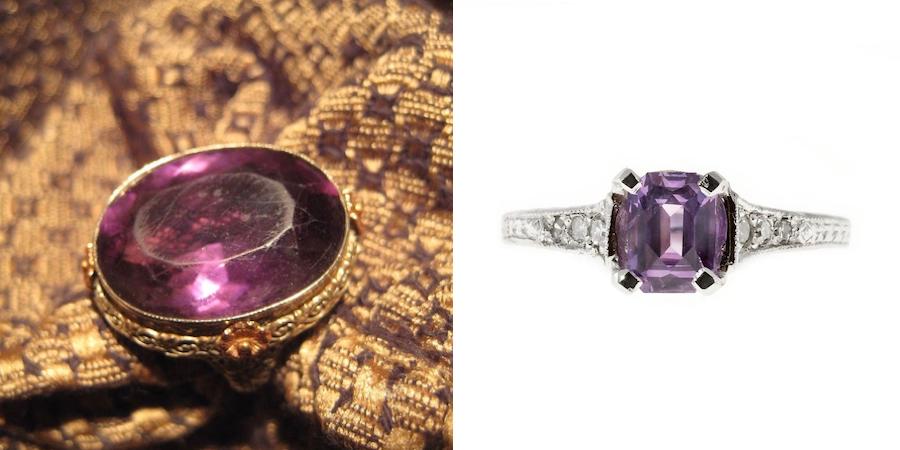
Left: Scratched Amethyst stone. | Right: Purple sapphire engagement ring.
Tanzanite burst onto the scene in 1967, and suddenly everyone wanted a Tanzanite engagement ring. It’s no wonder – it’s a gorgeous blue-violet that is quite uncommon in gems. However, at 6-6.5/10 on the Mohs Hardness Scale, it’s a bad idea for an engagement ring. Instead, couples looking for a Tanzanite engagement ring should look for Violet Spinel (like mine!). Spinel is much harder than Tanzanite and will hold up to daily wear much better.
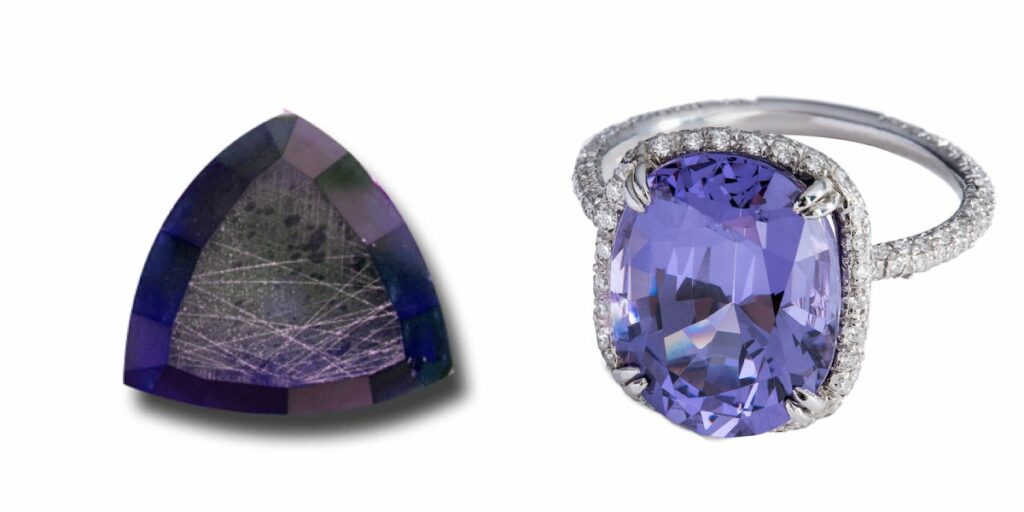
Left: Scratched Tanzanite gemstone. | Right: Violet Spinel engagement ring.
Moss Agate is a unique gemstone with organic, leaf-like inclusions. This kind of appearance is very popular with those who feel a connection with nature! Unfortunately, however, moss agate is a variety of quartz, meaning it is only a 7/10 on the hardness scale. This means it is risk for scratching, chipping, and generally becoming dull, like the ring below. We have helped many couples replace an original moss agate engagement ring that has sadly broken. Most of these couples opt for emerald or a unique green sapphire! Sapphire is a 9/10 hardness and comes in a ton of beautiful green shades – and it can even have great inclusions, reminiscent of moss agate. Nature-loving couples may also love emerald’s mossy “jardin” appearance – which actually means garden in French!

Scratched moss agate ring. Photo by spartcom5 on Antiquers.
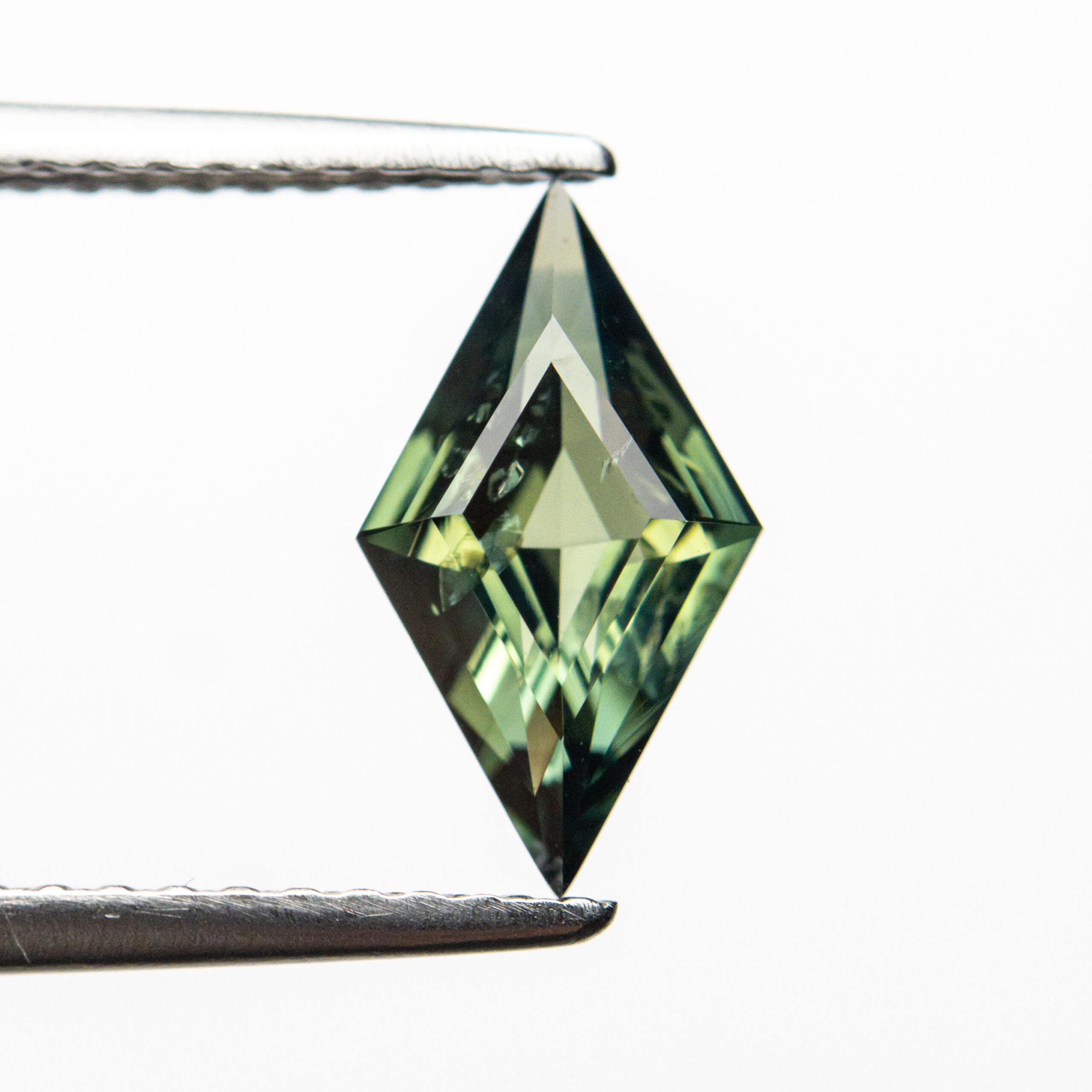
Natural green sapphire ring with lily-pad like inclusions.
I’d love to! Contact me here and describe the delicious color you’re looking for! I will walk you through what gemstone options are the most durable and find the perfect stone for you.
Ruby is a beautiful, durable, and rare red stone! It is part of the gemstone family corundum, meaning sapphire is its sister! However, this crimson beauty is special. In fact, ruby is the only color of corundum with a special name. That’s right! All the other colors of corundum – and it spans the whole rainbow! – are simply called sapphire. That is because this red gem is significantly more rare than its sibling.

Cushion Halo Engagement Ring
Yes! Rubies are one of the best engagement ring center stones because it is romantic, durable, and rare. As red is the most romantic color, red rubies are a natural choice! Also, being a 9 out of 10 on the hardness scale means this stone will stand up to daily wear and tear. In fact, it is the hardest natural gem on the planet, next to diamonds. Finally, they are a great choice for an engagement ring because they are rare, just like true love.
Yes. However, it sparkles differently than diamond. Specifically, its sparkle is a subtle red and orange/pink, whereas diamond gives off an extreme rainbow and white sparkle. So, if intense sparkle is your goal, you may wish to consider red diamond (we offer natural and color enhanced red diamonds too!) That said, ruby’s sparkle is elegant and stunning! Take a look below!
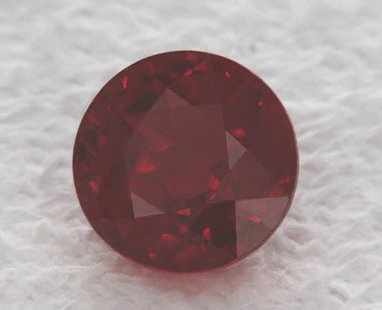
Sparkle and shimmer!
Sure! It is certainly hard enough to withstand daily wear and tear. That is because of this red stone’s 9/10 hardness on the Mohs Hardness Scale. As with any engagement ring (even diamond!), to keep it beautiful for everyday wear, we suggest keeping it clean and removing it before doing anything super physical.
They can, however, it is fairly rare. As you’ve read, they are very hard! However, a hard enough knock against something can chip even a diamond. So, always remove your rings before doing anything physical, like working out, doing dishes, or yard work.
Couples that love color, want to express their passion, or want something unique. This is a fantastic choice for those who love having color in their lives. It is bright, beautiful, and eye-catching! Also, for those who love showing their love to the world, this red stone is a great choice. Its bright red color shows that you put your love first! Finally, because ruby is so rare, those who want a unique engagement ring should definitely consider ruby. Fine gems are even rarer than diamond!
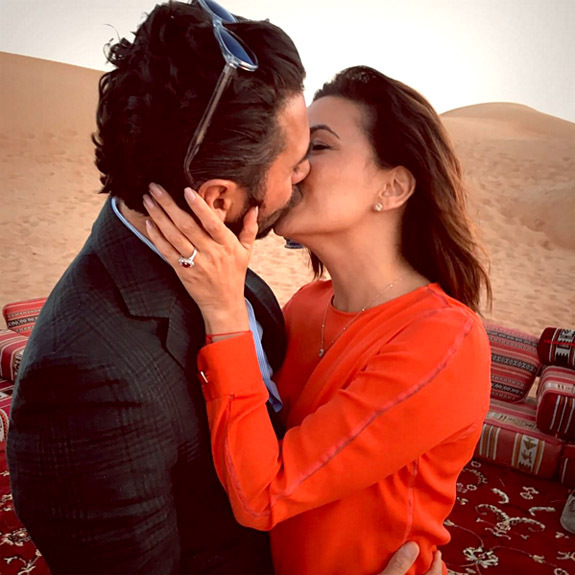
Eva Longoria’s Engagement Ring
Couples that want the traditional “white” engagement ring or those with extremely physical jobs. Obviously, this red gem is not white. So, if the look you are going for is a traditional colorless engagement ring, this isn’t the right stone for you! Also, those with intensely physical jobs (such as those which would cause the stone to scrape against other stones or metal constantly) should consider a very low-set diamond (such as a rose-cut) instead.
The most valuable stones are vivid red with no visible inclusions. However, this gem comes in all sorts of shades, and they may be orangey, pinkish, or purplish as well. In order to be called a “ruby”, corundum must be at least 51% red (decidedly NOT 51% pink, orange, or purple). The most valuable color is actually known as “pigeon blood” (I know, right).
A pigeon blood ruby is a natural ruby with a vivid slightly purplish red color. Legend has it that the nickname “pigeons blood” arose in Burma (current day Myanmar) where these gems were traditionally set in pure yellow gold. Because of the striking warmth of the yellow metal, in order for the gem to appear vivid red (and not orangey), the stone needed a blue/purple tint. So, gem traders began to use this somewhat gruesome term to describe purplish-Red gems, as blood also has this blue/purple tint.
Fun fact! Setting in white gold, rose gold, or platinum? You don’t need (or want) a purplish-red pigeon blood color. A bright red stone is your goal!
The best quality stones are vivid red, eye clean, and well-cut. Color is the most important factor, so look for a red that is not too heavily tinted pink, orange, or purple. Next, check out the stone up close. Look for any eye-visible imperfections. An eye clean stone will look flawless without magnification. Finally, a well-cut gem will have even color throughout the stone (no washed-out pool or dark area in the center), and will have fairly symmetrical faceting (facets on the left are a mirror image of those on the right).
Notably, due to this stone’s rarity, natural rubies will almost always have small cutting variances. That is because cutters use small inconsistencies to cut the largest, cleanest stones! However, the overall look of your stone should be symmetrical, and any inconsistencies should not be distracting.
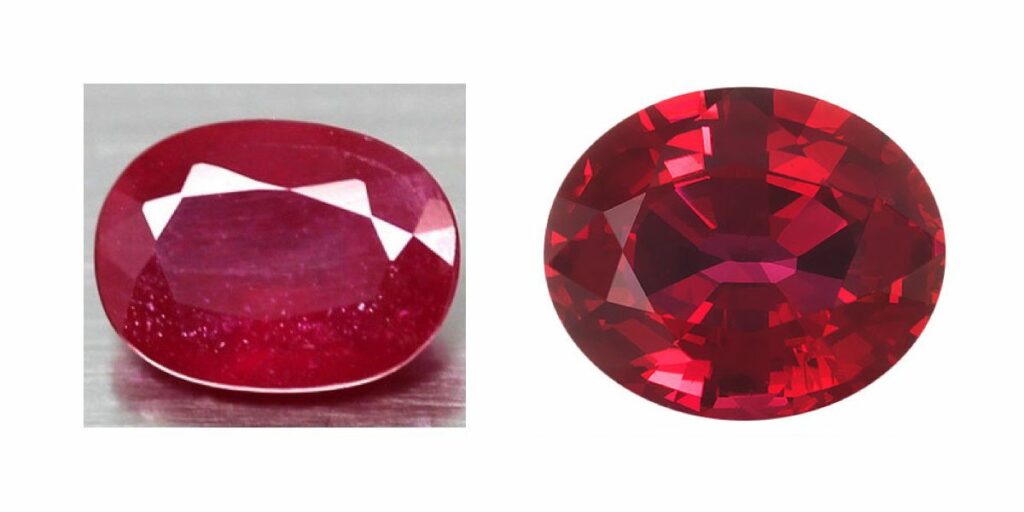
Poor Cutting & Clarity (Left) vs. Excellent Cutting & Clarity (Right)
Like diamonds, gemstones are judged by their quality and beauty. In colored gemstones, jewelers often use a B-AAA scale. “B” and “AB” quality stones are the least attractive, typically having no or low transparency and brilliance. “A” quality stones may have some visible inclusions but are more attractive. “AA” quality is a standard middle grade with good brilliance, cutting, and sparkle.
So, “AAA” is top quality in terms of color, clarity, cutting, and sparkle! To give you a visual, the poorly cut stone above would be an AB quality. On the other hand, the well-cut stone is an AAA! AAA rubies typically represent the top 10% of gems on the market. They are a more beautiful, richer red color, and their brilliance can’t be matched.
High-quality faceted ruby is completely transparent. “Transparency” refers to light’s ability to travel through a gemstone. So, if your stone is “transparent” it means that light is able to enter and bounce around your gem to make sparkle! “Translucent” refers to when a stone has inclusions which make light appear more billowy or gauzy – there are no crisp sparkles. Finally when a gem is “opaque” it means that light cannot travel through it at all.
Gemologist’s note: Star rubies are translucent or opaque – that’s ok, they’re graded differently!
Translucent Star (Left); Opaque Star (Right)
They are rubies…made in a lab! Interestingly, there is no chemical or visual difference between a natural and a lab-created gemstone (except that the lab stone will look more perfect!). So, when you choose a lab-created stone, you are getting the same beauty, hardness, and sparkle as its natural counterpart. The only difference is that it is made by man, and that it is a lot less expensive.
“Synthetic” is another name for Lab-Created. Just make sure you’re not getting a “simulant.” A simulant is a red stone that looks like a ruby, but is glass, plastic, or some other gemstone.
Yes! Lab-created stones are real! Natural and lab-created gems have the exact same chemical and optical properties – they are the same material! So, both natural and lab-created rubies are real. They just have different origins.
The only way to tell between a natural and a lab-created ruby is to have it tested. However, perfection in cutting + perfection in clarity can be a clue it is lab-created.
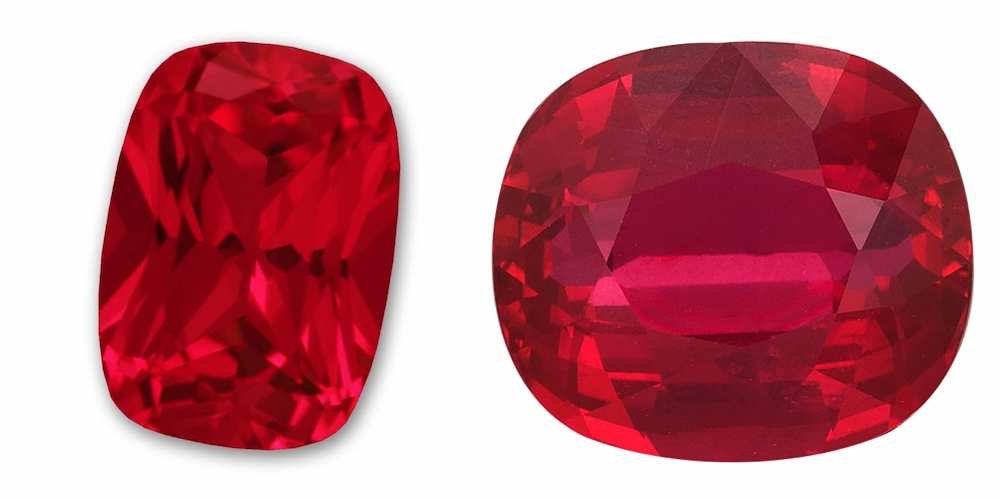
(Left) Lab Created vs Natural (Right)
While the only way to know for certain you have a ruby and not another red stone is to have it tested. Good indications of a natural ruby are inconsistencies in cutting, visible inclusions, and crisp facet edges. Even the highest quality natural stones will frequently have inconsistencies in cutting. This is because gem cutters will make an extra facet to cut off an imperfection, or leave the stone a little too long to add carat weight. So, if the red stone isn’t “perfect” looking, that’s a good clue that it may be natural.
Imperfections, or “inclusions”, are another way to tell. It is pretty rare that a synthetic stone has eye-visible inclusions. So, if your red stone has cracks or black spots, it is more likely to be natural. Finally, one way to tell ruby from other red stones is crisp facet edges. As it is a 9/10 on the hardness scale, it is less likely to chip.
Glass filling is an ill-advised treatment performed upon low quality “B” natural stones to make their inclusions less visible. It is not a permanent treatment, it will come out during normal ring cleaning. And, it makes a gem much less valuable. Unfortunately, these glass-filled stones are sometimes sold by unscrupulous dealers without a customer being aware. So, it is important to always purchase your gemstones from a jeweler with a sterling reputation. Always make sure to ask about your ruby’s treatment! The only acceptable treatment for a ruby is heat.
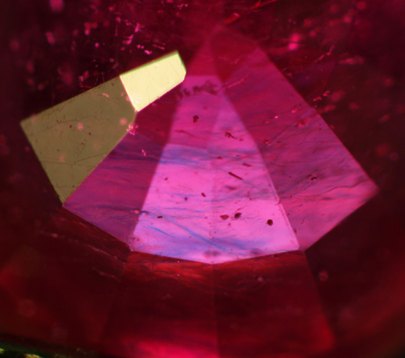
Glass filling under magnification
For an engagement ring, ruby is better than garnet due to is far greater durability. This is because garnet is only a 7-7.5 on the Mohs Hardness Scale. And, dust is a 7/10. So, that means that every time a garnet ring is cleaned with a cloth, it gets micro scratches. This will dull the stone over time. As a result, when considering rubies vs garnet, garnet is typically better for an occasional-wear ring, not an engagement.
While you cannot be certain without testing it, good clues to tell garnet vs ruby apart include color, clarity, facet edges, and cost. In other words, while there are certain garnets that can rival the color of a ruby, most garnets are a transparent dark brownish-red. Most rubies of this color will be more included (less transparent). Also, due to its lower hardness, garnet will show scratches and chips. Finally, when comparing rubies vs garnet, a pretty garnet will only be a fraction of the cost.
Antique ruby vs Antique garnet (with micro chips)
An AAA ruby is more unique, more colorful, and more rare than a diamond. A diamond, on the other hand, is harder, more brilliant, and more firey (remember those rainbow sparkles I was talking about?). So, it depends! Which do you like better when you compare rubies vs diamond?
Yes, high-end AAA natural stones are rarer than diamonds!
Round Ruby Engagement Ring vs. Diamond Engagement Ring
Rubies are measured in carats, however, they are heavier than diamonds. So, a one-carat ruby will measure smaller than a one-carat diamond. For example, one carat round rubies measure around 5.7mm, whereas one carat round diamonds measure around 6.5mm. To work with this, it is best to figure out what millimeter size you want instead of carat weight.
A 6.5mm (the size of a 1 carat diamond) round AAA quality natural ruby is $4,500+, whereas a lab created 6.5mm is $880. Check out the table below to see how this compares against their sister sapphire, and lab-created stones, too!
| 6.5mm Round AAA Natural | 6.5mm Round Lab Created | 6.5mm Round AAA Blue Sapphire | 1ct (6.5mm) Round I/VS2 Diamond | |
| Cost | $4,500+ | $880 | $2,760 | $4,000+ |
I sure can! Feel free to ask for me, Corinne, the gemologist. I’ll help you pick out a gorgeous stone and pair it with a ring that will bring out the love. Send me a note here, or email me at care@doamore.com!
An Elongated Cushion Cut is shaped like a rectangular pillow. Whereas many Cushion Cut gems are somewhat square, what makes an Elongated Cushion Cut different is its extraordinarily long length-to-width ratio (more on that below!). In other words, an Elongated Cushion Cut is tall and skinny! Elongated Cushion Cuts are typically brilliant cut gemstones, meaning that they give off a lot of sparkle.
The longer the cushion, the rarer the diamond! Diamonds that are only a little elongated, around 1.10 and below, are common. Stones between 1.11 and 1.18 are rarer, while stones above 1.19 are pretty hard to come by. So, if you’re looking for a really elongated stone, make sure to build in some time for your search!
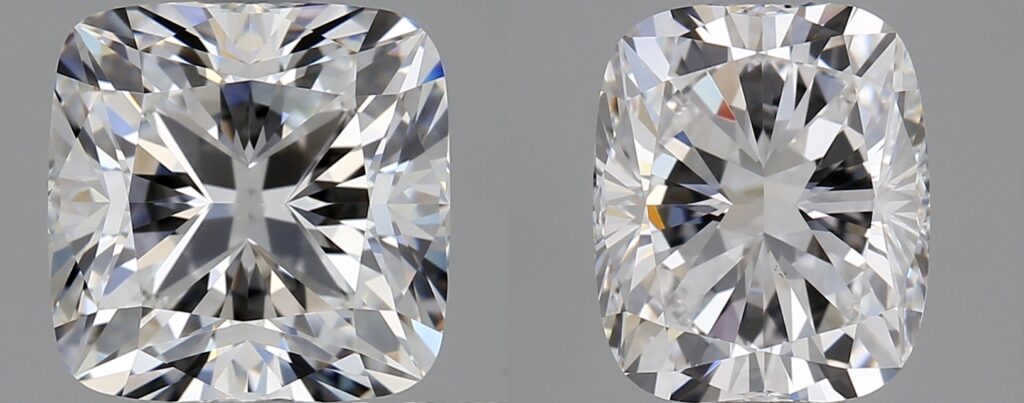
Left: Square Cushion Diamond | Right: Elongated Cushion Diamond
The best gemstones for an Elongated Cushion Engagement Ring are Diamond, Sapphire, Ruby, Spinel, and Garnet. These gems are the best choice for an Elongated Cushion Cut Engagement Ring because they are durable and naturally grow in long crystals. What’s great about choosing a long-crystal gem for your Elongated Cushion Cut Engagement Ring is that they will be less expensive (less waste during cutting) and you’ll have a better selection of stones to choose from.
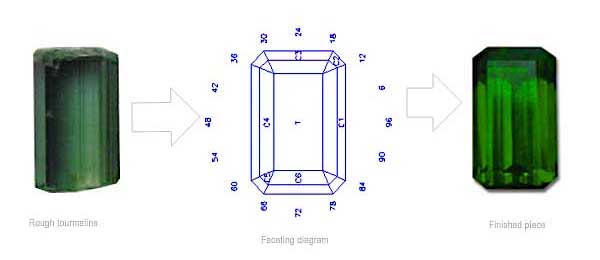
This may sound crazy, but the way you get what you really want is to slap a ruler on your finger! Because an Elongated Cushion Cut is really a look, you likely have an idea of what shape and size you’re going for. So, measure it out. Jewelers use millimeters when they measure gemstones. Use a ruler to find the length and width you want. This will also inform what gemstone is best for you (some crystals form bigger than others)!
Length-to-Width Ratio is a helpful measurement calculation which allows you to pick how plump or skinny your Elongated Cushion Cut is. To calculate a Length-to-Width Ratio, simply divide the gemstone’s width by its length. So, a Length-to-Width Ratio of 1.0 is perfectly square. On the other hand, bigger Length-to-Width Ratios will appear long and skinny. The defining feature of an Elongated Cushion Cut is that it’s, you guessed it, long. So, in order to get the look, you’ll want to choose a long Length-to-Width Ratio (think 1.15+ for diamonds and 1.4+ for gemstones).
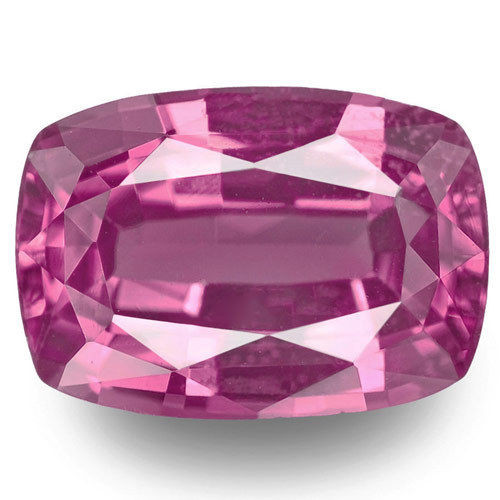
Pink Sapphire with 1.4 Length-to-Width Ratio
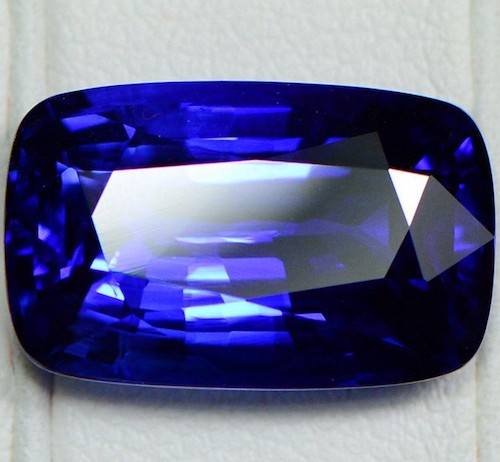
Blue Sapphire with 1.6 Length-to-Width Ratio
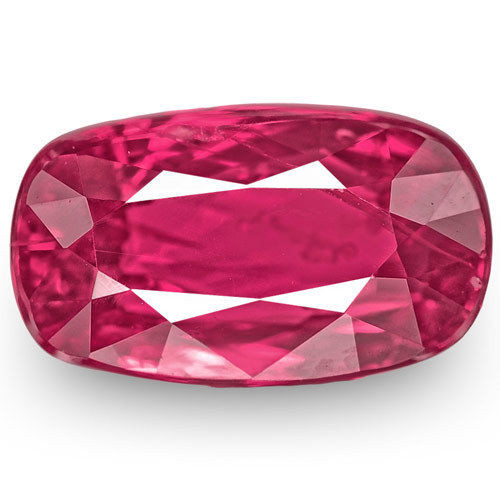
Ruby with 1.7 Length-to-Width Ratio
The next step is choosing your color and gemstone. The size and shape you chose will help you with this selection!
Those looking for a traditional colorless Elongated Cushion Cut Engagement Ring should check out these Diamonds and also consider White Sapphire and Moissanite. When looking for an Elongated Cushion Diamond, look for length-to-width ratios of 1.19 and above. Be warned, you will not likely find a cushion cut Diamond with a length-to-width ratio longer than 1.25 due to Diamond crystal shape. Natural White Sapphires longer than 1.4 are also rare. However, Lab White Sapphire, Moissanite, and Lab Diamonds can be grown and cut to very long lengths! So, if you have a long, elegant shape in mind, we can happily custom cut it for you.
Sneaky Trick: We know we always tell you to look for “Excellent” cut quality in our Diamonds. This one’s a special exception, though. Leave that part out for this round. The search engine will think these stones are “too long” and filter them out!

Those looking for a regal blue Elongated Cushion Cut Engagement Ring should look at Blue Sapphire and Blue Spinel (read here about the difference between these two stones). Because Sapphire and Spinel grow in nice long crystals, Elongated Cushion cuts are pretty common! Those looking for a larger stone will like the value that comes with Spinel. However, those looking for a deeper blue will likely find Sapphire more to their liking. Both Sapphire and Spinel are available in Lab-created versions, too.
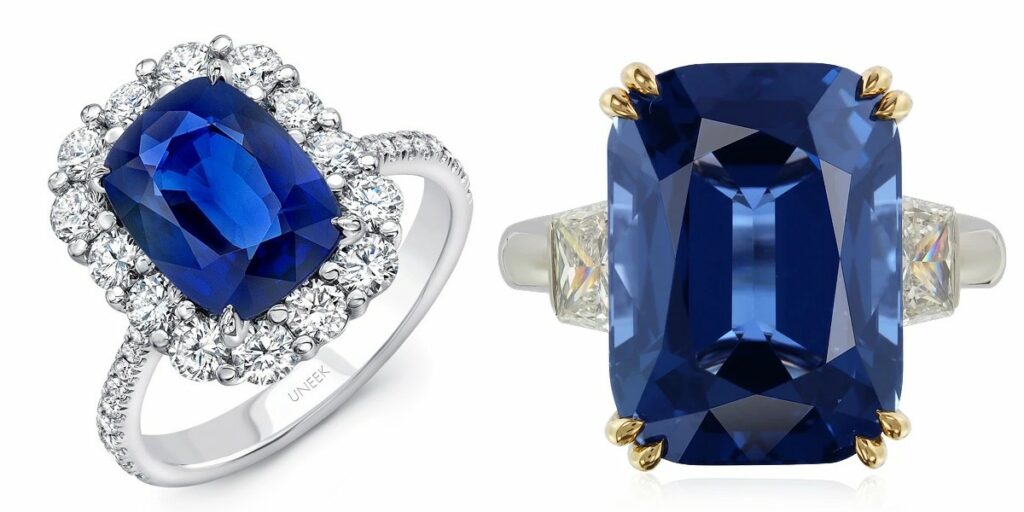
Left: Blue Sapphire | Right: Blue Spinel
Pretty pink Elongated Cushion Cut Engagement Rings may be made from Pink Sapphire or Pink Spinel. As with their blue cousins, couples looking for a larger stone will find a better value in Pink Spinel. However, Sapphire tends to be a purer pink and a harder gem. So, the choice is up to you! Again, both of these gems are available in Lab versions.
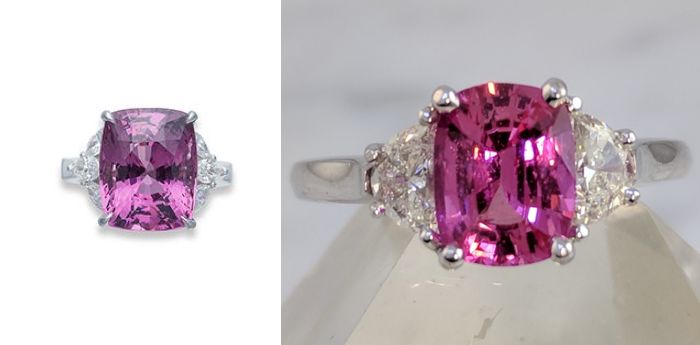
Left: Pink Sapphire | Right: Pink Spinel
Finally, those looking for a passionate red Elongated Cushion Cut Engagement Ring should consider Ruby, Red Spinel, and Garnet. Garnet is by far the most affordable of these options, with large stones often available under $1,000. Next comes Spinel, with large stones and more durability. Ruby is the rarest and most precious of these gems, and so commands the highest prices.

Left: Ruby | Middle: Red Spinel | Right: Garnet
Two really important things to look for in a high-quality Elongated Cushion Cut are facet symmetry and lack of bow-tie effect. Another thing to look out for is whether your stone is modern or antique.
Because Elongated Cushion Cuts are extra long (and often not considered “Excellent cut” for this reason), paying attention to the quality of its faceting is really important. This is because gemstones that fall outside of “Excellent” standard are often imperfect. But, as you can see, not always! You just chose a really special shape. “Facet symmetry” means that the little cuts all over your stone mirror each other from left to right. So, when looking for an Elongated Cushion Cut, draw an imaginary line down the center of your stone. Do they look like mirror halves? Bingo! If they look kinda haphazard, pass on it.
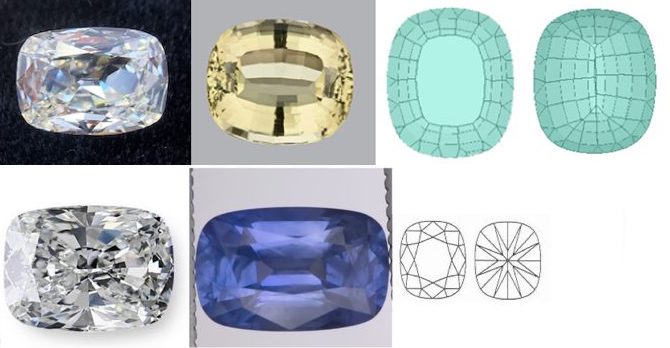
Top Row: Poor Symmetry | Bottom Row: Good Symmetry
Another thing to consider is whether the stone you’re purchasing has an antique cut or a traditional cut. There are a significant amount of Elongated Cushion diamonds out there that were faceted way before we really knew about how to maximize brilliance. In other words, while antique Elongated Cushions have a charm all their own (I adore them) they do not give off as much brilliance as modern Elongated Cushions. A quick way to look for this is a large culet (the bottom facet). If a stone has a large culet and less symmetrical facets, you’re looking at an antique stone!
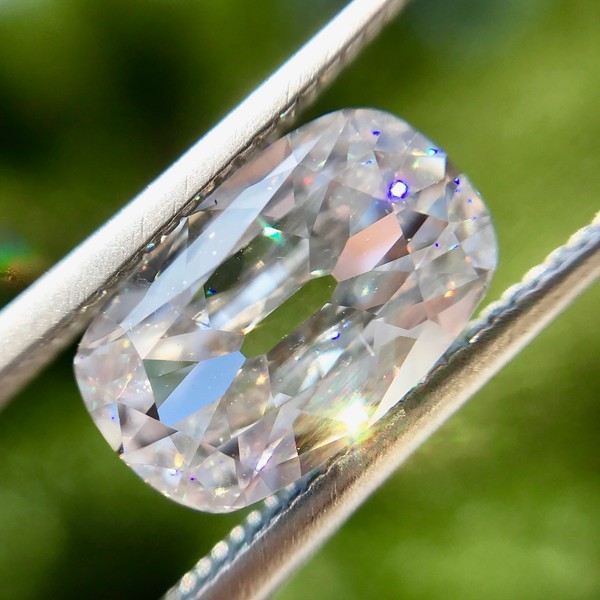
Antique Elongated Cushion Diamond
Because you’re choosing such a long stone, some gems will exhibit uneven light return. What I mean by that is the gem will be brighter in the center or on the ends, instead of being bright throughout. Don’t let uneven light return ruin your stone! Instead, look for even sparkle and light return in your Elongated Cushion Cut.
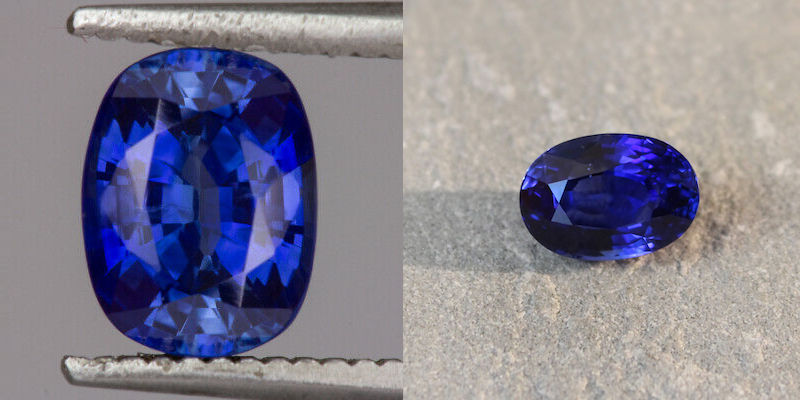
Left: Even Light Return; Right: Half/Half Extinction
I sure can! My name is Corinne, and I’m obsessed with them. Send me a note here, or email me here! Tell me everything you are looking for, or ask me any questions!